Advances in Quantitative Analytical Methods for Solid Drugs
Abstract
1. Introduction
2. Quantitative Analysis Methods
2.1. X-Ray Diffraction
Powder X-Ray Diffraction (PXRD)
2.2. Spectroscopy
2.2.1. Infrared Spectroscopy (IR)
Attenuated Total Reflectance Infrared Spectroscopy (ATR-FTIR)
Diffuse Reflectance Fourier-Transform Infrared Spectroscopy (DRIFTS)
2.2.2. Near-Infrared Spectroscopy (NIRS)
2.2.3. Raman Spectroscopy (Raman)
2.2.4. Terahertz (THz) Spectroscopy
2.2.5. Solid-State Nuclear Magnetic Resonance (SS-NMR)
2.3. Thermal Analysis Method
2.3.1. Differential Scanning Calorimetry (DSC)
2.3.2. Thermogravimetric Analysis (TGA)
2.4. Dynamic Vapor Sorption (DVS)
3. Advantages and Disadvantages of Solid-State Drug Quantification Methods
4. Conclusions and Prospect
Author Contributions
Funding
Conflicts of Interest
References
- Wang, L.D.S.; Dong, W. Research advances of polymorphism in pharmaceutical cocrystals. Chemcial Ind. Eng. 2018, 35, 29–37. [Google Scholar]
- Fong, S.Y.K.; Ibisogly, A.; Bauer-Brandl, A. Solubility enhancement of BCS Class II drug by solid phospholipid dispersions: Spray drying versus freeze-drying. Int. J. Pharm. 2015, 496, 382–391. [Google Scholar] [CrossRef] [PubMed]
- Bhalani, D.V.; Nutan, B.; Kumar, A.; Chandel, A.K.S. Bioavailability Enhancement Techniques for Poorly Aqueous Soluble Drugs and Therapeutics. Biomedicines 2022, 10, 2055. [Google Scholar] [CrossRef] [PubMed]
- Yuvaraja, K.; Khanam, J. Enhancement of carvedilol solubility by solid dispersion technique using cyclodextrins, water soluble polymers and hydroxyl acid. J. Pharm. Biomed. Anal. 2014, 96, 10–20. [Google Scholar] [CrossRef]
- Hisada, N.; Takano, R.; Takata, N.; Shiraki, K.; Ueto, T.; Tanida, S.; Kataoka, M.; Yamashita, S. Characterizing the dissolution profiles of supersaturable salts, cocrystals, and solvates to enhance in vivo oral absorption. Eur. J. Pharm. Biopharm. 2016, 103, 192–199. [Google Scholar] [CrossRef] [PubMed]
- Dubey, A.; Kumar, S.; Sachan, A.K.; Yadav, K. Techniques For Increasing Solubility: A Review Of Conventional And New Strategies. Asian J. Pharm. Res. Dev. 2022, 10, 144–153. [Google Scholar]
- McCrone, W.C. Physics and Chemistry of the Organic Solid State; Inderscience Publishers: Geneva, Switzerland, 1965; Volume 2, pp. 725–767. [Google Scholar]
- Shi, Q.; Chen, H.; Wang, Y.; Xu, J.; Liu, Z.; Zhang, C. Recent advances in drug polymorphs: Aspects of pharmaceutical properties and selective crystallization. Int. J. Pharm. 2022, 611, 121320. [Google Scholar] [CrossRef]
- Wong, S.N.; Chen, Y.C.S.; Xuan, B.; Sun, C.C.; Chow, S.F. Cocrystal engineering of pharmaceutical solids: Therapeutic potential and challenges. CrystEngComm 2021, 23, 7005–7038. [Google Scholar] [CrossRef]
- Food and Drug Administration. Guide for industry. Regulatory Classification of Pharmaceutical Co-Crystals; Food and Drug Administration: Silver Spring, MD, USA, 2018. [Google Scholar]
- Kozakiewicz-Latała, M.; Junak, A.; Złocińska, A.; Pudło, W.; Prusik, K.; Szymczyk-Ziółkowska, P.; Karolewicz, B.; Nartowski, K.P. Adjusting the melting point of an Active Pharmaceutical Ingredient (API) via cocrystal formation enables processing of high melting drugs via combined hot melt and materials extrusion (HME and ME). Addit. Manuf. 2022, 60, 103196. [Google Scholar] [CrossRef]
- Bhatt, J.A.; Bahl, D.; Morris, K.; Stevens, L.L.; Haware, R.V. Structure-mechanics and improved tableting performance of the drug-drug cocrystal metformin:salicylic acid. Eur. J. Pharm. Biopharm. 2020, 153, 23–35. [Google Scholar] [CrossRef] [PubMed]
- Chettri, A.; Subba, A.; Singh, G.P.; Bag, P.P. Pharmaceutical co-crystals: A green way to enhance drug stability and solubility for improved therapeutic efficacy. J. Pharm. Pharmacol. 2024, 76, 1–12. [Google Scholar] [CrossRef]
- Xia, M.; Jiang, Y.; Cheng, Y.; Dai, W.; Rong, X.; Zhu, B.; Mei, X. Rucaparib cocrystal: Improved solubility and bioavailability over camsylate. Int. J. Pharm. 2023, 631, 122461. [Google Scholar] [CrossRef] [PubMed]
- Chen, H.; Ma, J.; Zhou, F.; Yang, J.; Jiang, L.; Chen, Q.; Zhou, Y.; Zhang, J. A potential cocrystal strategy to tailor in-vitro dissolution and improve Caco-2 permeability and oral bioavailability of berberine. Int. J. Pharm. 2024, 666, 124789. [Google Scholar] [CrossRef] [PubMed]
- Ma, C.Y.; Moldovan, A.A.; Maloney, A.G.P.; Roberts, K.J. Exploring the CSD Drug Subset: An Analysis of Lattice Energies and Constituent Intermolecular Interactions for the Crystal Structures of Pharmaceuticals. J. Pharm. Sci. 2023, 112, 435–445. [Google Scholar] [CrossRef] [PubMed]
- Paiva, E.M.; da Silva, V.H.; Poppi, R.J.; Pereira, C.F.; Rohwedder, J.J.R. Comparison of macro and micro Raman measurement for reliable quantitative analysis of pharmaceutical polymorphs. J. Pharm. Biomed. Anal. 2018, 157, 107–115. [Google Scholar] [CrossRef]
- Singh, K.; Bajaj, N.; Kashyap, M.; Bandyopadhyay, A.; Sengupta, A. Applications of multi-parameter sensing in pharmaceutical, agriculture and mineral industries using THz spectroscopy and Low-Wavenumber Raman spectroscopy. Opt. Laser Technol. 2024, 177, 111020. [Google Scholar] [CrossRef]
- Shang, Z.; Liu, M.; Hu, W.; Deng, T.; Su, X.; Hou, B.; Wang, J.; Gong, J. Construction and application of a qualitative and quantitative analysis system of three boscalid polymorphs based on solid-state analytical methods and chemometric tools. CrystEngComm 2022, 24, 3096–3108. [Google Scholar] [CrossRef]
- Yao, Z.; Guochuan, F.; Zhen, W. Principle of X-ray diffraction and phase analysis of doped graphene. J. Hebei North Univ. 2018, 34, 10–14. [Google Scholar]
- Xin, L. Application of wavelength dispersive X-ray fluorescence spectrometer and polycrystalline X-ray diffraction spectrometry identification of imports of copper and copper materials. Chin. J. Inorg. Anal. Chem. 2018, 8, 21–25. [Google Scholar]
- Ali, A.; Chiang, Y.W.; Santos, R.M. X-ray Diffraction Techniques for Mineral Characterization: A Review for Engineers of the Fundamentals, Applications, and Research Directions. Minerals 2022, 12, 205. [Google Scholar] [CrossRef]
- Yan, X.; Jing, W.; Qiu, Y.; Yong, W.; Ying, B.; Hong, H. Quantitative Analyzing Methods for Polymorphism of Pharmaceuticals. Petrochem. Technol. 2015, 44, 11–18+10. [Google Scholar]
- Feng, P.Z.Y.; Ting, Z.; Si, X.; Jia, S.; Kang, S. Quantitative Analysis of Magnetite Spinel Content in Copper Flash Converting Slag by X-ray Diffraction (XRD). Chin. J. Inorg. Anal. Chem. 2023, 1–10. [Google Scholar] [CrossRef]
- Sundaram, M.; Natarajan, S.; Dikundwar, A.G.; Bhutani, H. Quantification of solid-state impurity with powder X-ray diffraction using laboratory source. Powder Diffr. 2020, 35, 226–232. [Google Scholar] [CrossRef]
- Mei, M.E.; Yu, L.I.; Yang, W. Application of X-ray Powder Diffraction to Quantitative Analysis of Pharmaceutical Polymorphism. Chin. J. Mod. Appl. Pharm. 2017, 34, 1356–1360. [Google Scholar]
- Qiu, J.-B.; Li, G.; Sheng, Y.; Zhu, M.-R. Quantification of febuxostat polymorphs using powder X-ray diffraction technique. J. Pharm. Biomed. Anal. 2015, 107, 298–303. [Google Scholar] [CrossRef] [PubMed]
- Alexander, L.; Klug, H.P. Basic aspects of X-ray absorption in quantitative diffraction analysis of powder mixtures. Anal. Chem. 1948, 20, 886–889. [Google Scholar] [CrossRef]
- Lou, Y.; Zuo, L. Quantification of losartan potassium polymorphs using powder X-ray diffraction. J. AOAC Int. 2021, 104, 579–584. [Google Scholar] [CrossRef] [PubMed]
- Chambi, J.T.; Prado, L.D.; de Carvalho Patricio, B.F.; Ceballos, M.; Bianco, I.; Fandaruff, C.; Rocha, H.V.A.; Kuznetsov, A.; Cuffini, S.L. Quantitative analysis and evaluation of solid-state stability of mebendazole Forms A and C suspensions by powder X-ray diffraction using the Rietveld method. Int. J. Pharm. 2024, 650, 123721. [Google Scholar] [CrossRef]
- Siddiqui, A.; Rahman, Z.; Korang-Yeboah, M.; Khan, M.A. Development and validation of X-ray diffraction method for quantitative determination of crystallinity in warfarin sodium products. Int. J. Pharm. 2015, 493, 1–6. [Google Scholar] [CrossRef]
- Kommavarapu, P.; Maruthapillai, A.; Palanisamy, K. Identification and quantitative determination of eletriptan hydrobromide polymorphs: Thermal, diffractometric and spectrometric studies. J. Taibah Univ. Sci. 2018, 9, 586–593. [Google Scholar] [CrossRef][Green Version]
- Beyer, A.; Grohganz, H.; Löbmann, K.; Rades, T.; Leopold, C.S. Multivariate Quantification of the Solid State Phase Composition of Co-Amorphous Naproxen-Indomethacin. Molecules 2015, 20, 19571–19587. [Google Scholar] [CrossRef]
- Otsuka, Y.; Ito, A.; Matsumur, S.; Takeuchi, M.; Pal, S.; Tanak, H. Quantification of Pharmaceutical Compounds Based on Powder X-Ray Diffraction with Chemometrics. Chem. Pharm. Bull. 2016, 64, 1129–1135. [Google Scholar] [CrossRef] [PubMed]
- Sun, M.; Hu, X.; Zhou, X.; Gu, J. Determination of minor quantities of linezolid polymorphs in a drug substance and tablet formulation by powder X-ray diffraction technique. Powder Diffr. 2017, 32, 78–85. [Google Scholar] [CrossRef]
- Zappi, A.; Maini, L.; Galimberti, G.; Caliandro, R.; Melucci, D. Quantifying API polymorphs in formulations using X-ray powder diffraction and multivariate standard addition method combined with net analyte signal analysis. Eur. J. Pharm. Sci. 2019, 130, 36–43. [Google Scholar] [CrossRef] [PubMed]
- Sadul, S.K.; Perumal, A.; Somanath, T.; Kalaivani. Development and Validation of Method for the Estimation of Tacrolimus Crystalline API in Tacrolimus Extended Release Capsules 0.5mg, 1mg and 5mg by Power X-ray diffractometer (PXRD). Res. J. Pharm. Tech. 2020. [Google Scholar] [CrossRef]
- Beć, K.B.; Grabska, J.; Huck, C.W. Biomolecular and bioanalytical applications of infrared spectroscopy – A review. Anal. Chim. Acta 2020, 1133, 150–177. [Google Scholar] [PubMed]
- Ozaki, Y. Infrared Spectroscopy—Mid-infrared, Near-infrared, and Far-infrared/Terahertz Spectroscopy. Anal. Sci. 2021, 37, 1193–1212. [Google Scholar] [CrossRef]
- Liu, X.; Qing, H.; Ding, J.; Zhu, Q.; He, A.; Yue, .S.; Li, X. Using barium fluoride fine particles as stationary phase for TLC/FTIR analysis. Spectrosc. Spectr. Anal. 2011, 31, 1767–1771. [Google Scholar]
- Haas, J.; Mizaikoff, B. Advances in Mid-Infrared Spectroscopy for Chemical Analysis. Annu. Rev. Anal. Chem. 2016, 9, 45–68. [Google Scholar] [CrossRef]
- Yang, Y.C.; Li, R.X.; Liu, G.Y. Study on the Thermo—oxidative Degradation Behavior of ABS Resin Based on the TGA —FTIR Hyphenated Technique. J. Instrum. Anal. 2010, 29, 777. [Google Scholar]
- Lin, C.; Ling, C.; Ya-Shan, Z.; Han, S.; Rong, L. Advances in the research of domestic Drug Polymorphism. Strait Pharm. J. 2020, 32, 1–4. [Google Scholar]
- Gauglitz, G.; Moore, D.S. Handbook of Spectroscopy; Wiley-Vch: Weinheim, Germany, 2014; Volume 1. [Google Scholar]
- Suárez, L.; García, R.; Riera, F.A.; Diez, M.A. ATR-FTIR spectroscopy for the determination of Na4EDTA in detergent aqueous solutions. Talanta. 2013, 115, 652–656. [Google Scholar] [CrossRef]
- Carolei, L.; Gutz, I.G. Simultaneous determination of three surfactants and water in shampoo and liquid soap by ATR-FTIR. Talanta. 2005, 66, 118–124. [Google Scholar] [CrossRef] [PubMed]
- Kapourani, A.; Valkanioti, V.; Kontogiannopoulos, K.N.; Barmpalexis, P. Determination of the physical state of a drug in amorphous solid dispersions using artificial neural networks and ATR-FTIR spectroscopy. Int. J. Pharm. X 2020, 2, 100064. [Google Scholar] [CrossRef]
- Hongo, T.; Fukuda, S. TRANSMISSION ELECTRON MICROSCOPY AND FOURIER-TRANSFORM INFRARED SPECTROSCOPY STUDIES OF CHRYSOTILE DISSOLUTION USING A FLOW-THROUGH METHOD. Clay Sci. 2023, 27, 41–48. [Google Scholar]
- Zhang, J.; He, X.; Wan, R. Application of Diffuse Reflectance Fourier Transform Infrared Spectroscopy in Quantitative Analysis. Phys. Test. Chem. Anal. Part B Chem. Anal 2015, 51, 1347–1362. [Google Scholar]
- Xin, H.; An-Xin, L.; Jin, Z. Simultaneous analysis of SO42- and NO3- in soil by diffuse reflectance Fourier transform infrared spectroscopy. Chin. J. Anal. Lab. 2015, 34, 1428–1431. [Google Scholar]
- Yang, P.W.; Mantsch, H.H.; Baudais, F. A critical evaluation of three types of diffuse reflectance infrared accessories. Appl. Spectrosc. 1986, 40, 974–978. [Google Scholar] [CrossRef]
- Kubelka, P. Ein Beitrag zur Optik der Farbanstriche (Contribution to the optic of paint). Z. Fur. Tech. Phys. 1931, 12, 593–601. [Google Scholar]
- Braga, J.W.B.; Poppi, R.J. Figures of merit for the determination of the polymorphic purity of carbamazepine by infrared spectroscopy and multivariate calibration. J. Pharm. Sci. 2004, 93, 2124–2134. [Google Scholar] [CrossRef] [PubMed]
- Hartauer, K.J.; Miller, E.S.; Guillory, J.K. Diffuse reflectance infrared Fourier transform spectroscopy for the quantitative analysis of mixtures of polymorphs. Int. J. Pharm. 1992, 85, 163–174. [Google Scholar] [CrossRef]
- Hamadeh, I.M.; Yeboah, S.A.; Trumbull, K.A.; Griffiths, P.R. Preparation of calibration standards for quantitative diffuse reflectance infrared spectrometry. Appl. Spectrosc. 1984, 38, 486–491. [Google Scholar] [CrossRef]
- Brimmer, P.J.; Griffiths, P.R. Effect of absorbing matrixes on diffuse reflectance infrared spectra. Anal. Chem. 1986, 58, 2179–2184. [Google Scholar] [CrossRef]
- Olinger, J.M.; Griffiths, P.R. Quantitative effects of an absorbing matrix on near-infrared diffuse reflectance spectra. Anal. Chem. 1988, 60, 2427–2435. [Google Scholar] [CrossRef]
- Yeboah, S.A.; Wang, S.-H.; Griffiths, P.R. Effect of pressure on diffuse reflectance infrared spectra of compressed powders. Appl. Spectrosc. 1984, 38, 259–264. [Google Scholar] [CrossRef]
- Brimmer, P.J.; Griffiths, P.R. Angular dependence of diffuse reflectance infrared spectra. Part III: Linearity of Kubelka-Munk plots. Appl. Spectrosc. 1988, 42, 242–247. [Google Scholar] [CrossRef]
- Brimmer, P.J.; Griffiths, P.R. Angular dependence of diffuse reflectance infrared spectra. Part II: Effect of polarization. Appl. Spectrosc. 1987, 41, 791–797. [Google Scholar] [CrossRef]
- Manley, M. Near-infrared spectroscopy and hyperspectral imaging: Non-destructive analysis of biological materials. Chem. Soc. Rev. 2014, 43, 8200–8214. [Google Scholar] [CrossRef] [PubMed]
- Munawar, A.A.; Zulfahrizal; Meilina, H.; Pawelzik, E. Near infrared spectroscopy as a fast and non-destructive technique for total acidity prediction of intact mango: Comparison among regression approaches. Comput. Electron. Agric. 2022, 193, 106657. [Google Scholar] [CrossRef]
- Si, L.; Ni, H.; Pan, D.; Zhang, X.; Xu, F.; Wu, Y.; Bao, L.; Wang, Z.; Xiao, W.; Wu, Y. Nondestructive qualitative and quantitative analysis of Yaobitong capsule using near-infrared spectroscopy in tandem with chemometrics. Spectrochim. Acta Part A Mol. Biomol. Spectrosc. 2021, 252, 119517. [Google Scholar] [CrossRef]
- Heinz, A.; Strachan, C.J.; Gordon, K.C.; Rades, T. Analysis of solid-state transformations of pharmaceutical compounds using vibrational spectroscopy. J. Pharm. Pharmacol. 2009, 61, 971–988. [Google Scholar] [CrossRef] [PubMed]
- Wang, H.-P.; Chen, P.; Dai, J.-W.; Liu, D.; Li, J.-Y.; Xu, Y.-P.; Chu, X.-L. Recent advances of chemometric calibration methods in modern spectroscopy: Algorithms, strategy, and related issues. TrAC Trends Anal. Chem. 2022, 153, 116648. [Google Scholar] [CrossRef]
- Liu, M.; Liu, J.; Wang, Q.; Song, P.; Li, H.; Wu, S.; Gong, J. Quantitative analysis of low content polymorphic impurities in canagliflozin tablets by PXRD, NIR, ATR-FITR and Raman solid-state analysis techniques combined with stoichiometry. Spectrochim. Acta Part A Mol. Biomol. Spectrosc. 2023, 293, 122458. [Google Scholar] [CrossRef]
- Korang-Yeboah, M.; Akhtar, S.; Siddiqui, A.; Rahman, Z.; Khan, M.A. Application of NIR chemometric methods for quantification of the crystalline fraction of warfarin sodium in drug product. Drug Dev. Ind. Pharm. 2016, 42, 584–594. [Google Scholar] [CrossRef] [PubMed]
- Warnecke, S.; Wu, J.X.; Rinnan, Å.; Allesø, M.; van den Berg, F.; Jepsen, P.U.; Engelsen, S.B. Quantifying crystalline α-lactose monohydrate in amorphous lactose using terahertz time domain spectroscopy and near infrared spectroscopy. Vib. Spectrosc. 2019, 102, 39–46. [Google Scholar] [CrossRef]
- Wood, C.; Alwati, A.; Halsey, S.; Gough, T.; Brown, E.; Kelly, A.; Paradkar, A. Near infra red spectroscopy as a multivariate process analytical tool for predicting pharmaceutical co-crystal concentration. J. Pharm. Biomed. Anal. 2016, 129, 172–181. [Google Scholar] [CrossRef] [PubMed]
- Otsuka, M.; Nishizawa, J.-I.; Shibata, J.; Ito, M. Quantitative evaluation of mefenamic acid polymorphs by terahertz-chemometrics. J. Pharm. Sci. 2010, 99, 4048–4053. [Google Scholar] [CrossRef]
- Ren, J.; Mao, S.; Lin, J.; Xu, Y.; Zhu, Q.; Xu, N. Research Progress of Raman Spectroscopy and Raman Imaging in Pharmaceutical Analysis. Curr. Pharm. Des. 2022, 28, 1445–1456. [Google Scholar] [CrossRef] [PubMed]
- El-Gizawy, S.A.; Osman, M.A.; Arafa, M.F.; El Maghraby, G.M. Aerosil as a novel co-crystal co-former for improving the dissolution rate of hydrochlorothiazide. Int. J. Pharm. 2015, 478, 773–778. [Google Scholar] [CrossRef]
- Hertrampf, A.; Sousa, R.; Menezes, J.; Herd, T. Semi-quantitative prediction of a multiple API solid dosage form with a combination of vibrational spectroscopy methods. J. Pharm. Biomed. Anal. 2016, 124, 246–253. [Google Scholar] [CrossRef] [PubMed]
- Jones, R.R.; Hooper, D.C.; Zhang, L.; Wolverson, D.; Valev, V.K. Raman Techniques: Fundamentals and Frontiers. Nanoscale Res. Lett. 2019, 14, 231. [Google Scholar] [CrossRef]
- Li, K.; Liu, Q.; Cheng, H.; Deng, Y.; Frost, R.L. The molecular structure of chloritoid: A mid-infrared and near-infrared spectroscopic study. Spectrochim. Acta Part A Mol. Biomol. Spectrosc. 2015, 145, 604–609. [Google Scholar] [CrossRef] [PubMed]
- Sun, Z.; Lin, B.; Yang, X.; Zhao, B.; Zhang, H.; Dong, Q.; Zhong, L.; Zhang, S.; Zhang, M.; Xu, X.; et al. Review of the Application of Raman Spectroscopy in Qualitative and Quantitative Analysis of Drug Polymorphism. Curr. Top. Med. Chem. 2023, 23, 1340–1351. [Google Scholar] [CrossRef] [PubMed]
- Shipp, D.W.; Sinjab, F.; Notingher, I. Raman spectroscopy: Techniques and applications in the life sciences. Adv. Opt. Photonics 2017, 9, 315–428. [Google Scholar] [CrossRef]
- Koide, T.; Takeuchi, Y.; Otaki, T.; Yamamoto, K.; Shimamura, R.; Ohashi, R.; Inoue, M.; Fukami, T.; Izutsu, K.-I. Quantification of a cocrystal and its dissociated compounds in solid dosage form using transmission Raman spectroscopy. J. Pharm. Biomed. Anal. 2020, 177, 112886. [Google Scholar] [CrossRef]
- Barmpalexis, P.; Karagianni, A.; Nikolakakis, I.; Kachrimanis, K. Artificial neural networks (ANNs) and partial least squares (PLS) regression in the quantitative analysis of cocrystal formulations by Raman and ATR-FTIR spectroscopy. J. Pharm. Biomed. Anal. 2018, 158, 214–224. [Google Scholar] [CrossRef] [PubMed]
- Inoue, M.; Osada, T.; Hisada, H.; Koide, T.; Fukami, T.; Roy, A.; Carriere, J. Quantitative Monitoring of Cocrystal Polymorphisms in Model Tablets Using Transmission Low-Frequency Raman Spectroscopy. J. Pharm. Sci. 2023, 112, 225–229. [Google Scholar] [CrossRef] [PubMed]
- Feng, H.; Bondi, R.W.; Anderson, C.A.; Drennen, J.K.; Igne, B. Investigation of the sensitivity of transmission Raman spectroscopy for polymorph detection in pharmaceutical tablets. Appl. Spectrosc. 2017, 71, 1856–1867. [Google Scholar] [CrossRef]
- Inoue, M.; Hisada, H.; Koide, T.; Fukami, T.; Roy, A.; Carriere, J.; Heyler, R. Transmission low-frequency Raman spectroscopy for quantification of crystalline polymorphs in pharmaceutical tablets. Anal. Chem. 2019, 91, 1997–2003. [Google Scholar] [CrossRef] [PubMed]
- Tozuka, Y.; Ito, A.; Seki, H.; Oguchi, T.; Yamamoto, K. Characterization and quantitation of clarithromycin polymorphs by powder X-ray diffractometry and solid-state NMR spectroscopy. Chem. Pharm. Bull. 2002, 50, 1128–1130. [Google Scholar] [CrossRef][Green Version]
- Bawuah, P.; Zeitler, J.A. Advances in terahertz time-domain spectroscopy of pharmaceutical solids: A review. TrAC Trends Anal. Chem. 2021, 139, 116272. [Google Scholar] [CrossRef]
- Zhang, L.; Yuan, P.-H.; Yang, D.-Z.; Bi, Y.-C.; Su, B.; Zhang, B.-X.; Wang, F.-Q.; Lu, Y.; Du, G.-H. Purity and Uncertainty Study of CRM Betulin by DSC. Nat. Prod. Bioprospecting 2020, 10, 317–324. [Google Scholar] [CrossRef]
- Withayachumnankul, W.; Ferguson, B.; Rainsford, T.; Mickan, S.; Abbott, D. Simple material parameter estimation via terahertz time-domain spectroscopy. Electron. Lett. 2005, 41, 800–801. [Google Scholar] [CrossRef]
- Hong, Z.; Min, G.; Wen, W.; Qing, L.; Xiao, Y. Application of Teraherz Time Domain Spectroscopy in Chemistry and Biology. Chem. Bull. 2005, 2, 87–93. [Google Scholar]
- Neu, J.; Schmuttenmaer, C.A. Tutorial: An introduction to terahertz time domain spectroscopy (THz-TDS). J. Appl. Phys. 2018, 124, 231101. [Google Scholar] [CrossRef]
- He, M.; Guo, S. Research on application of terahertz technology in drugs. J. Electron. Meas. Instrum 2012, 26, 663–672. [Google Scholar] [CrossRef]
- Jiang, Y.; Shen, Y.; Wu, P. Application of ATR-FTIR spectroscopy in polymer film study. Prog. Chem. 2007, 19, 173. [Google Scholar]
- Huang, S.; Deng, H.; Wei, X.; Zhang, J. Progress in application of terahertz time-domain spectroscopy for pharmaceutical analyses. Front. Bioeng. Biotechnol. 2023, 11, 1219042. [Google Scholar] [CrossRef] [PubMed]
- Xiao-Jing, M.; Hong-Wei, Z.; Bin, D.; Gui-Feng, L. THz spectra of hypoxanthine and inosine. Acta Phys. Sin. 2008, 57, 3429–3434. [Google Scholar] [CrossRef]
- Liu, J.; Fan, L. Qualitative and quantitative determination of potassium aluminum sulfate dodecahydrate in potato starch based on terahertz spectroscopy. Microw. Opt. Technol. Lett. 2020, 62, 525–530. [Google Scholar] [CrossRef]
- Vieira, F.S.; Pasquini, C. Determination of cellulose crystallinity by terahertz-time domain spectroscopy. Anal. Chem. 2014, 86, 3780–3786. [Google Scholar] [CrossRef] [PubMed]
- Da Silva, V.H.; Vieira, F.S.; Rohwedder, J.J.R.; Pasquini, C.; Pereira, C.F. Multivariate quantification of mebendazole polymorphs by terahertz time domain spectroscopy (THZ-TDS). Anal. 2017, 142, 1519–1524. [Google Scholar] [CrossRef] [PubMed]
- Vemuri, V.D.; Lankalapalli, S.; Guntaka, P.C.R. Posaconazole-amino acid cocrystals for improving solubility and oral bioavailability while maintaining antifungal activity and low In vivo toxicity. J. Drug Deliv. Sci. Technol. 2022, 74, 103491. [Google Scholar] [CrossRef]
- Li-xin, L.; Feng, D.; Guang-jin, H. Quantitative Cross Polarization Magic-Angle Spinning NMR Spectroscopy in Solids. Chin. J. Magn. Reson. 2020, 37, 1–15. [Google Scholar]
- Ting, C.; Qi, L.; Qi, L.; Shi, Y.; Yang, L. Application of Solid-state Nuclear Magnetic Resonance Technology in the Research of Crystalline Drugs. Her. Med. 2022, 41, 655–663. [Google Scholar]
- Stephenson, G.A.; Forbes, R.A.; Reutzel-Edens, S.M. Characterization of the solid state: Quantitative issues. Adv. Drug Deliv. Rev. 2001, 48, 67–90. [Google Scholar] [CrossRef]
- Li, M.; Xu, W.; Su, Y. Solid-state NMR spectroscopy in pharmaceutical sciences. TrAC Trends Anal. Chem. 2021, 135, 116152. [Google Scholar] [CrossRef]
- Achanta, P.S.; Niemitz, M.; Friesen, J.B.; Tadjimukhamedov, F.K.; Bzhelyansky, A.; Giancaspro, G.I.; Chen, S.-N.; Pauli, G.F. Pharmaceutical analysis by NMR can accommodate strict impurity thresholds: The case of choline. J. Pharm. Biomed. Anal. 2022, 214, 114709. [Google Scholar] [CrossRef] [PubMed]
- Calvo, N.L.; Maggio, R.M.; Kaufman, T.S. Chemometrics-assisted solid-state characterization of pharmaceutically relevant materials. Polymorphic substances. J. Pharm. Biomed. Anal. 2018, 147, 518–537. [Google Scholar] [CrossRef]
- Tinmanee, R.; Larsen, S.C.; Morris, K.R.; Kirsch, L.E. Quantification of gabapentin polymorphs in gabapentin/excipient mixtures using solid state 13 C NMR spectroscopy and X-ray powder diffraction. J. Pharm. Biomed. Anal. 2017, 146, 29–36. [Google Scholar] [CrossRef]
- da Silva, V.H.; Gonçalves, J.L.; Vasconcelos, F.V.C.; Pimentel, M.F.; Pereira, C.F. Quantitative analysis of mebendazole polymorphs in pharmaceutical raw materials using near-infrared spectroscopy. J. Pharm. Biomed. Anal. 2015, 115, 587–593. [Google Scholar] [CrossRef]
- Feng, Y.; Li, X.; Xu, K.; Zou, H.; Li, H.; Liang, B. Qualitative and simultaneous quantitative analysis of cimetidine polymorphs by ultraviolet–visible and shortwave near-infrared diffuse reflectance spectroscopy and multivariate calibration models. J. Pharm. Biomed. Anal. 2015, 104, 112–121. [Google Scholar] [CrossRef] [PubMed]
- Antonio, M.; Maggio, R.M. Assessment of mefenamic acid polymorphs in commercial tablets using chemometric coupled to MIR and NIR spectroscopies. Prediction of dissolution performance. J. Pharm. Biomed. Anal. 2018, 149, 603–611. [Google Scholar] [CrossRef] [PubMed]
- da Silva, V.H.; Soares-Sobrinho, J.L.; Pereira, C.F.; Rinnan, Å. Evaluation of chemometric approaches for polymorphs quantification in tablets using near-infrared hyperspectral images. Eur. J. Pharm. Biopharm. 2019, 134, 20–28. [Google Scholar] [CrossRef]
- Liu, M.; Fu, R.; Liu, J.; Song, P.; Li, H.; Dong, W.; Sun, Z. Quantitative Analysis of Amorphous Form in Indomethacin by Near Infrared Spectroscopy Combined with Partial Least Squares Regression Analysis. Molecules 2024, 29, 5290. [Google Scholar] [CrossRef]
- Guo, C.; Luo, X.; Zhou, X.; Shi, B.; Wang, J.; Zhao, J.; Zhang, X. Quantitative analysis of binary polymorphs mixtures of fusidic acid by diffuse reflectance FTIR spectroscopy, diffuse reflectance FT-NIR spectroscopy, Raman spectroscopy and multivariate calibration. J. Pharm. Biomed. Anal. 2017, 140, 130–136. [Google Scholar] [CrossRef]
- Xie, Y.; Zhou, J.; Zhang, B.; Zhang, L.; Yang, D.; Yang, S.; Fang, L.; Lu, Y.; Du, G. Quality control of naringenin-carbamazepine drug-drug cocrystal: Quantitative analytical method construction of ATR-FTIR and Raman combined with chemometrics. Microchem. J. 2024, 202, 110774. [Google Scholar] [CrossRef]
- Zhou, J.; Zhang, B.; Gong, L.; Hu, K.; Yang, S.; Lu, Y. Quantitative analysis of pyrazinamide polymorphs in ternary mixtures by ATR-FTIR and Raman spectroscopy with multivariate calibration. Vib. Spectrosc. 2024, 130, 103625. [Google Scholar] [CrossRef]
- Mah, P.T.; Fraser, S.J.; Reish, M.E.; Rades, T.; Gordon, K.C.; Strachan, C.J. Use of low-frequency Raman spectroscopy and chemometrics for the quantification of crystallinity in amorphous griseofulvin tablets. Vib. Spectrosc. 2015, 77, 10–16. [Google Scholar] [CrossRef]
- Lipiäinen, T.; Fraser-Miller, S.J.; Gordon, K.C.; Strachan, C.J. Direct comparison of low- and mid-frequency Raman spectroscopy for quantitative solid-state pharmaceutical analysis. J. Pharm. Biomed. Anal. 2018, 149, 343–350. [Google Scholar] [CrossRef]
- Karimi-Jafari, M.; Soto, R.; Albadarin, A.B.; Croker, D.; Walker, G. In-line Raman spectroscopy and chemometrics for monitoring cocrystallisation using hot melt extrusion. Int. J. Pharm. 2021, 601, 120555. [Google Scholar] [CrossRef] [PubMed]
- Rimsha, G.; Shahbaz, M.; Majeed, M.I.; Nawaz, H.; Rashid, N.; Akram, M.W.; Shabbir, I.; Kainat, K.; Amir, A.; Sultan, E.; et al. Raman Spectroscopy for the Quantitative Analysis of Solid Dosage Forms of the Active Pharmaceutical Ingredient of Febuxostat. ACS Omega 2023, 8, 41451–41457. [Google Scholar] [CrossRef] [PubMed]
- Virtanen, T.; Maunu, S.L. Quantitation of a polymorphic mixture of an active pharmaceutical ingredient with solid state 13C CPMAS NMR spectroscopy. Int. J. Pharm. 2010, 394, 18–25. [Google Scholar] [CrossRef]
- Maruyoshi, K.; Iuga, D.; Watts, A.E.; Hughes, C.E.; Harris, K.D.M.; Brown, S.P. Assessing the Detection Limit of a Minority Solid-State Form of a Pharmaceutical by 1H Double-Quantum Magic-Angle Spinning Nuclear Magnetic Resonance Spectroscopy. J. Pharm. Sci. 2017, 106, 3372–3377. [Google Scholar] [CrossRef] [PubMed]
- Hirsh, D.A.; Wijesekara, A.V.; Carnahan, S.L.; Hung, I.; Lubach, J.W.; Nagapudi, K.; Rossini, A. Rapid Characterization of Formulated Pharmaceuticals Using Fast MAS 1H Solid-State NMR Spectroscopy. J. Mol. Pharm. 2019, 16, 3121–3132. [Google Scholar] [CrossRef] [PubMed]
- Wong, Y.T.A.; Aspers, R.L.E.G.; Uusi-Penttilä, M.; Kentgens, A.P.M. Rapid Quantification of Pharmaceuticals via 1H Solid-State NMR Spectroscopy. Anal. Chem. 2022, 94, 16667–16674. [Google Scholar] [CrossRef] [PubMed]
- Li, M.; Lu, X.; Xu, W.; Troup, G.M.; McNevin, M.J.; Nie, H.; Su, Y. Quantifying Pharmaceutical Formulations from Proton Detected Solid-State NMR under Ultrafast Magic Angle Spinning. J. Pharm. Sci. 2020, 109, 3045–3053. [Google Scholar] [CrossRef] [PubMed]
- Hong, Y.-L.; Reddy, G.N.M.; Nishiyama, Y. Selective detection of active pharmaceutical ingredients in tablet formulations using solid-state NMR spectroscopy. Solid State Nucl. Magn. Reson. 2020, 106, 101651. [Google Scholar] [CrossRef] [PubMed]
- Baraldi, L.; Bassanetti, I.; Mileo, V.; Amadei, F.; Sartori, A.; Venturi, L. Quantitation of Commercially Available API Solid Forms by Application of the NMR-qSRC Approach: An Optimization Strategy Based on In Silico Simulations. Anal. Chem. 2021, 93, 9049–9055. [Google Scholar] [CrossRef] [PubMed]
- Hao, C.; Jin, J.; Xiong, J.; Yang, Z.; Gao, L.; Ma, Y.; Liu, B.-F.; Liu, X.; Chen, Y.; Zhang, G. Polymorphs of DP-VPA solid solutions and their physicochemical properties. J. Pharm. Sci. 2020, 109, 2156–2165. [Google Scholar] [CrossRef]
- Wardhana, Y.W.; Hardian, A.; Chaerunisa, A.Y.; Suendo, V.; Soewandhi, S.N. Kinetic estimation of solid state transition during isothermal and grinding processes among efavirenz polymorphs. Heliyon 2020, 6, e03876. [Google Scholar] [CrossRef] [PubMed]
- Nakajima, T. An extrapolation scheme for solid-state NMR chemical shift calculations. Chem. Phys. Lett. 2017, 677, 99–106. [Google Scholar] [CrossRef]
- Staub, H.; Perron, W. New method of purity determination by means of calorimetric differential thermal analysis. Anal. Chem. 1974, 46, 128–130. [Google Scholar] [CrossRef]
- Faroongsarng, D.; Kadejinda, W.; Sunthornpit, A. Thermal behavior of a pharmaceutical solid acetaminophen doped with p-aminophenol. AAPS PharmSciTech 2000, 1, 62–68. [Google Scholar] [CrossRef]
- Araújo, A.A.S.; Bezerra, M.D.S.; Storpirtis, S.; Matos, J.D.R. Determination of the melting temperature, heat of fusion, and purity analysis of different samples of zidovudine (AZT) using DSC. Braz. J. Pharm. Sci. 2010, 46, 37–43. [Google Scholar] [CrossRef]
- Kestens, V.; Roebben, G.; Linsinger, T. Development and validation of a differential scanning calorimetry purity determination method for polycyclic aromatic hydrocarbons. Accredit. Qual. Assur. 2010, 15, 269–281. [Google Scholar] [CrossRef]
- Tong, H.H.; Shekunov, B.Y.; York, P.; Chow, A.H. Thermal analysis of trace levels of polymorphic impurity in salmeterol xinafoate samples. Pharm. Res. 2003, 20, 1423–1429. [Google Scholar] [CrossRef] [PubMed]
- Wong, S.N.; Chan, S.W.S.; Peng, X.; Xuan, B.; Lee, H.W.; Tong, H.H.; Chow, S.F. Effects of the glass-forming ability and annealing conditions on cocrystallization behaviors via rapid solvent removal: A case study of voriconazole. Pharmaceutics 2020, 12, 1209. [Google Scholar] [CrossRef] [PubMed]
- Hou, X.; Feng, Y.; Zhang, P.; Wei, H.; Dang, L. Selective crystal growth of theophylline-saccharin cocrystal on self-assembled monolayer from incongruent system. Cryst. Growth Des. 2015, 15, 4918–4924. [Google Scholar] [CrossRef]
- Aitipamula, S.; Wong, A.B.; Chow, P.S.; Tan, R.B. Polymorphism and phase transformations of a cocrystal of nicotinamide and pimelic acid. CrystEngComm 2012, 14, 8193–8198. [Google Scholar] [CrossRef]
- Bruni, G.; Maggi, L.; Monteforte, F.; Ferrara, C.; Capsoni, D.; Berbenni, V.; Milanese, C.; Girella, A.; Friuli, V.; Mustarelli, P. Zaltoprofen/4, 4′-Bipyridine: A Case Study to Demonstrate the Potential of Differential Scanning Calorimetry (DSC) in the Pharmaceutical Field. J. Pharm. Sci. 2021, 110, 3690–3701. [Google Scholar] [CrossRef]
- Bruni, G.; Maggi, L.; Mustarelli, P.; Sakaj, M.; Friuli, V.; Ferrara, C.; Berbenni, V.; Girella, A.; Milanese, C.; Marini, A. Enhancing the pharmaceutical behavior of nateglinide by cocrystallization: Physicochemical assessment of cocrystal formation and informed use of differential scanning calorimetry for its quantitative characterization. J. Pharm. Sci. 2019, 108, 1529–1539. [Google Scholar] [CrossRef] [PubMed]
- Bruni, G.; Capsoni, D.; Milanese, C.; Cardini, A. Polymorphic quantification of dexketoprofen trometamol by differential scanning calorimetry. J. Therm. Anal. Calorim. 2022, 148, 1949–1958. [Google Scholar] [CrossRef]
- Liu, M.; Shi, P.; Wang, G.; Wang, G.; Song, P.; Liu, Y.; Wu, S.; Gong, J. Quantitative analysis of binary mixtures of entecavir using solid-state analytical techniques with chemometric methods. Arab. J. Chem. 2021, 14, 103360. [Google Scholar] [CrossRef]
- Tong, H.H.; Shekunov, B.Y.; Chan, J.P.; Mok, C.K.; Hung, H.C.; Chow, A.H. An improved thermoanalytical approach to quantifying trace levels of polymorphic impurity in drug powders. Int. J. Pharm. 2005, 295, 191–199. [Google Scholar] [CrossRef]
- Lefort, R.; De Gusseme, A.; Willart, J.-F.; Danede, F.; Descamps, M. Solid state NMR and DSC methods for quantifying the amorphous content in solid dosage forms: An application to ball-milling of trehalose. Int. J. Pharm. 2004, 280, 209–219. [Google Scholar] [CrossRef]
- Pindelska, E.; Sokal, A.; Kolodziejski, W. Pharmaceutical cocrystals, salts and polymorphs: Advanced characterization techniques. Adv. Drug Deliv. Rev. 2017, 117, 111–146. [Google Scholar] [CrossRef]
- Jing, X.; Xialin, D.; Lan, H.; Xiang, W. Research Progress in Characterization Methods of Pharmaceutical Cocrystals. Chin. J. Pharmacovigil. 2021, 18, 995. [Google Scholar]
- Ferreira, P.O.; de Moura, A.; de Almeida, A.C.; Santos, É.C.D.; Kogawa, A.C.; Caires, F.J. Mechanochemical synthesis, thermoanalytical study and characterization of new multicomponent solid forms of norfloxacin with saccharin. J. Therm. Anal. Calorim. 2022, 1–13. [Google Scholar] [CrossRef]
- Fernandes, R.P.; Nascimento, A.L.C.S.D.; Carvalho, A.C.S.; Teixeira, J.A.; Ionashiro, M.; Caires, F.J. Mechanochemical synthesis, characterization, and thermal behavior of meloxicam cocrystals with salicylic acid, fumaric acid, and malic acid. J. Therm. Anal. Calorim. 2019, 138, 765–777. [Google Scholar] [CrossRef]
- Ferreira, L.T.; Alarcon, R.T.; Perpétuo, G.L.; Bannach, G. Investigation and characterization by TG/DTG–DTA and DSC of the fusion of Riboflavin, and its interaction with the antibiotic norfloxacin in the screening of cocrystal. J. Therm. Anal. Calorim. 2019, 136, 581–588. [Google Scholar] [CrossRef]
- Torquetti, C.; Ferreira, P.O.; de Almeida, A.C.; Fernandes, R.P.; Caires, F.J. Thermal study and characterization of new cocrystals of ciprofloxacin with picolinic acid. J. Therm. Anal. Calorim. 2021, 1–8. [Google Scholar] [CrossRef]
- Liu, H.; Tong, H.H.; Zhou, Z. Feasibility of thermal methods on screening, characterization and physicochemical evaluation of pharmaceutical cocrystals. J. Therm. Anal. Calorim. 2022, 1–17. [Google Scholar] [CrossRef]
- Guizani, C.; Trogen, M.; Zahra, H.; Pitkänen, L.; Moriam, K.; Rissanen, M.; Mäkelä, M.; Sixta, H.; Hummel, M. Fast and quantitative compositional analysis of hybrid cellulose-based regenerated fibers using thermogravimetric analysis and chemometrics. Cellulose 2021, 28, 6797–6812. [Google Scholar] [CrossRef] [PubMed]
- Sheokand, S.; Modi, S.R.; Bansal, A.K. Dynamic Vapor Sorption as a Tool for Characterization and Quantification of Amorphous Content in Predominantly Crystalline Materials. J. Pharm. Sci. 2014, 103, 3364–3376. [Google Scholar] [CrossRef]
- Young, P.M.; Chiou, H.; Tee, T.; Traini, D.; Chan, H.-K.; Thielmann, F.; Burnett, D. The Use of Organic Vapor Sorption to Determine Low Levels of Amorphous Content in Processed Pharmaceutical Powders. Drug Dev. Ind. Pharm. 2008, 33, 91–97. [Google Scholar] [CrossRef]
- Hancock, G.Z.B.C. The Relationship Between the Glass Transition Temperature and the Water Content of Amorphous Pharmaceutical Solids. Pharm. Res. 1994, 11, 471–477. [Google Scholar] [CrossRef]
- Buckton, P.D.G. The use of gravimetric studies to assess the degree of crystallinity of predominantly crystalline powders. Int. J. Pharm. 1995, 123, 265–271. [Google Scholar] [CrossRef]
- Bagwan, N.U.S.; Sheokand, S.; Kaur, A.; Dubey, G.; Puri, V.; Bharatam, P.V.; Bansal, A.K. Role of surface molecular environment and amorphous content in moisture sorption behavior of milled Terbutaline Sulphate. Eur. J. Pharm. Sci. 2021, 161, 105782. [Google Scholar] [CrossRef] [PubMed]
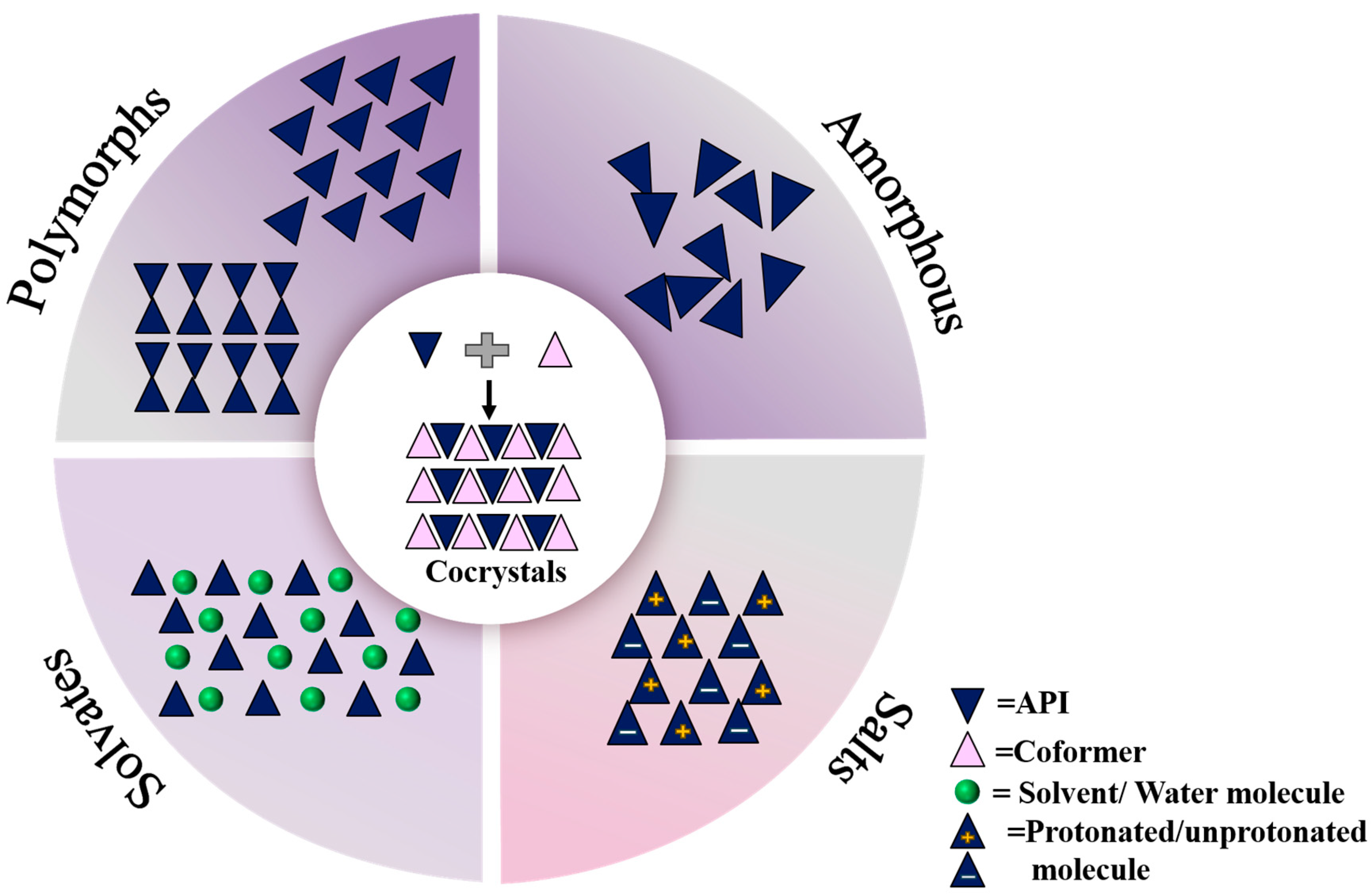

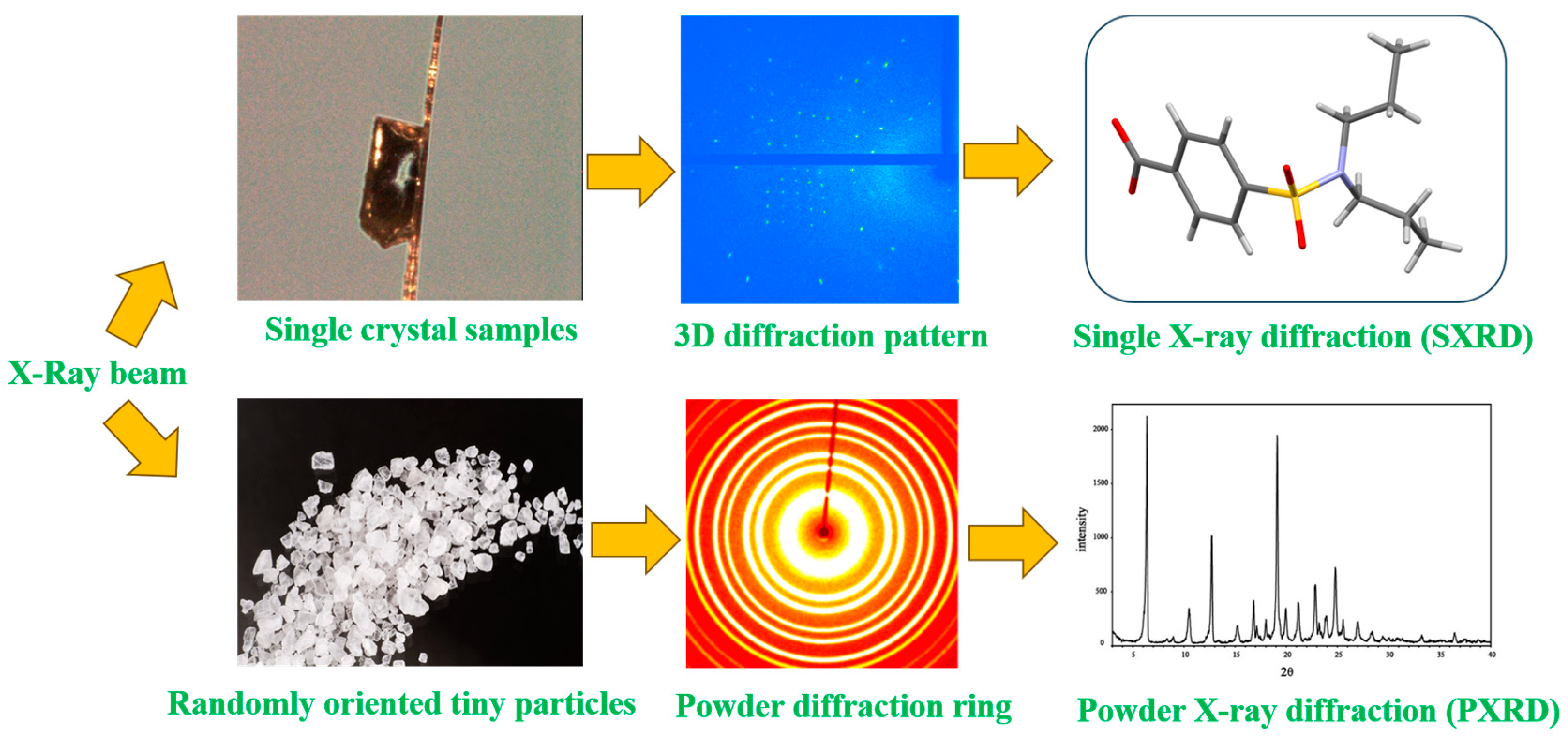
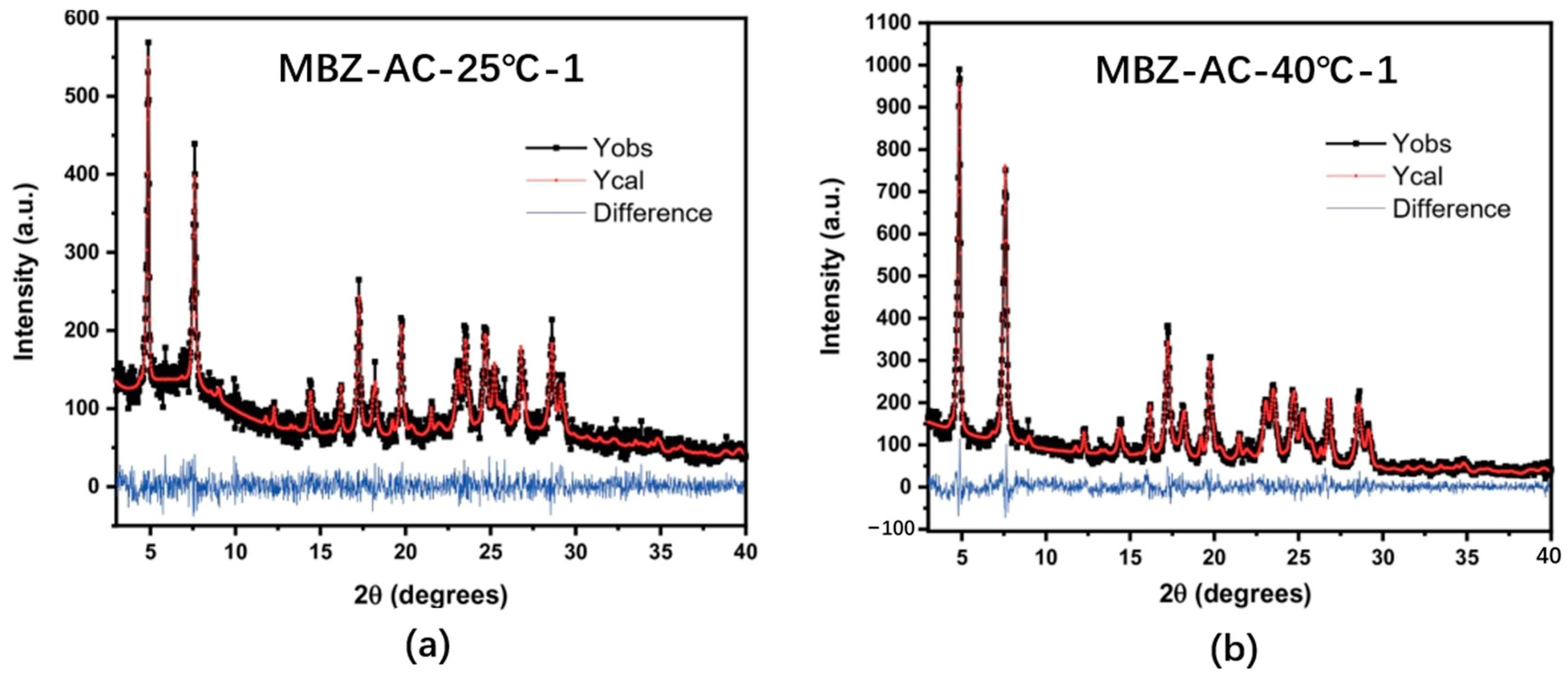
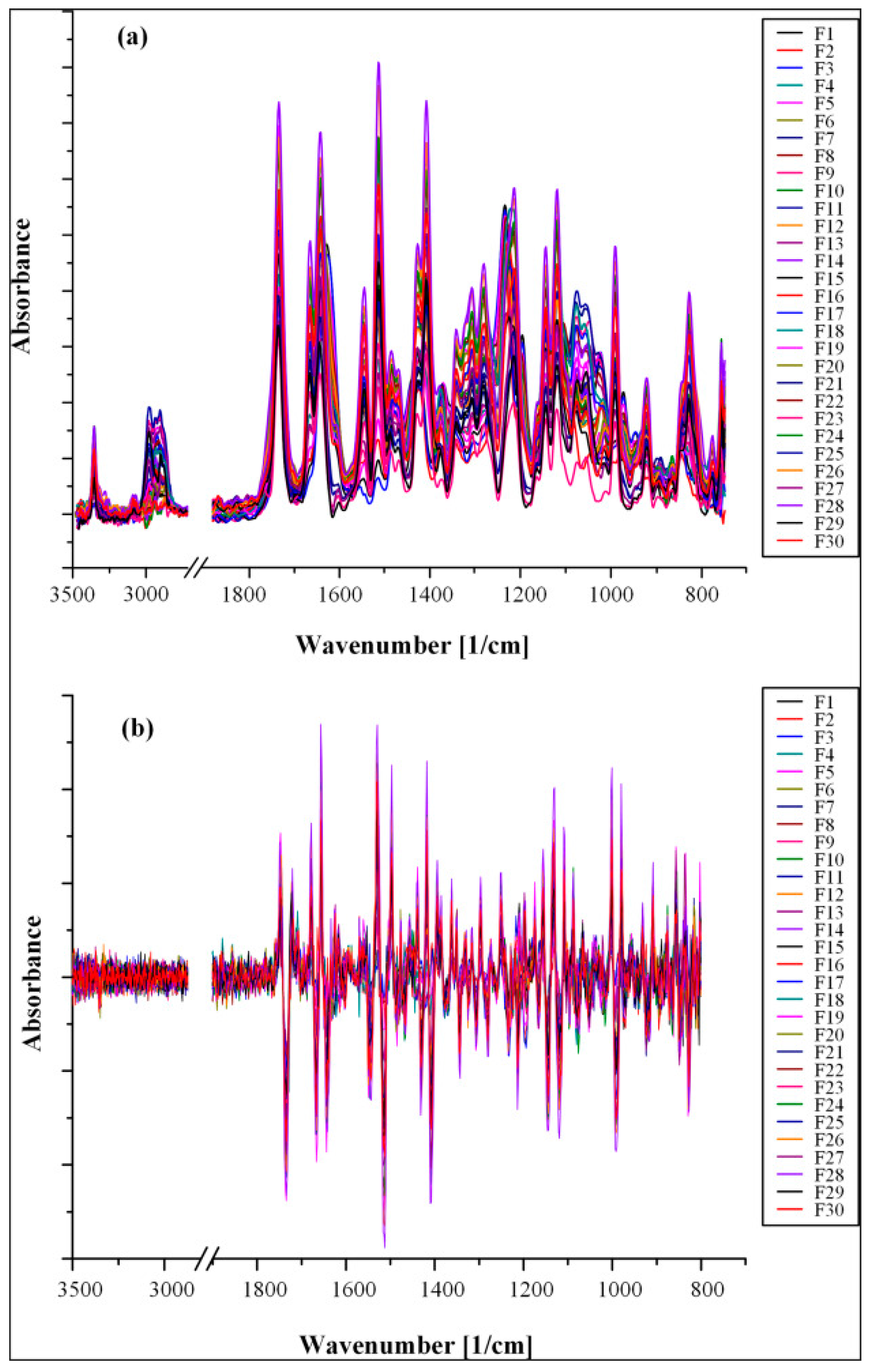

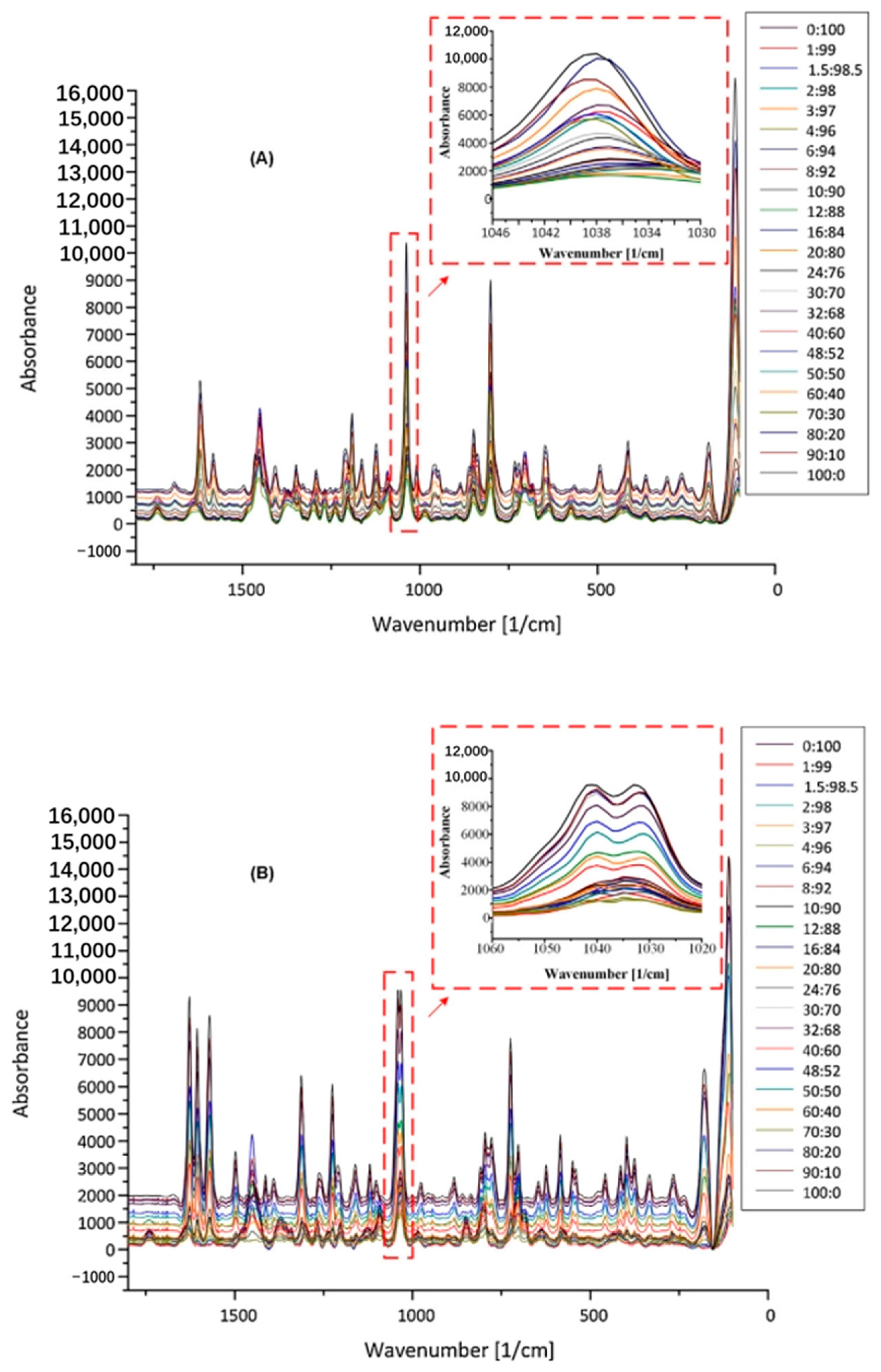
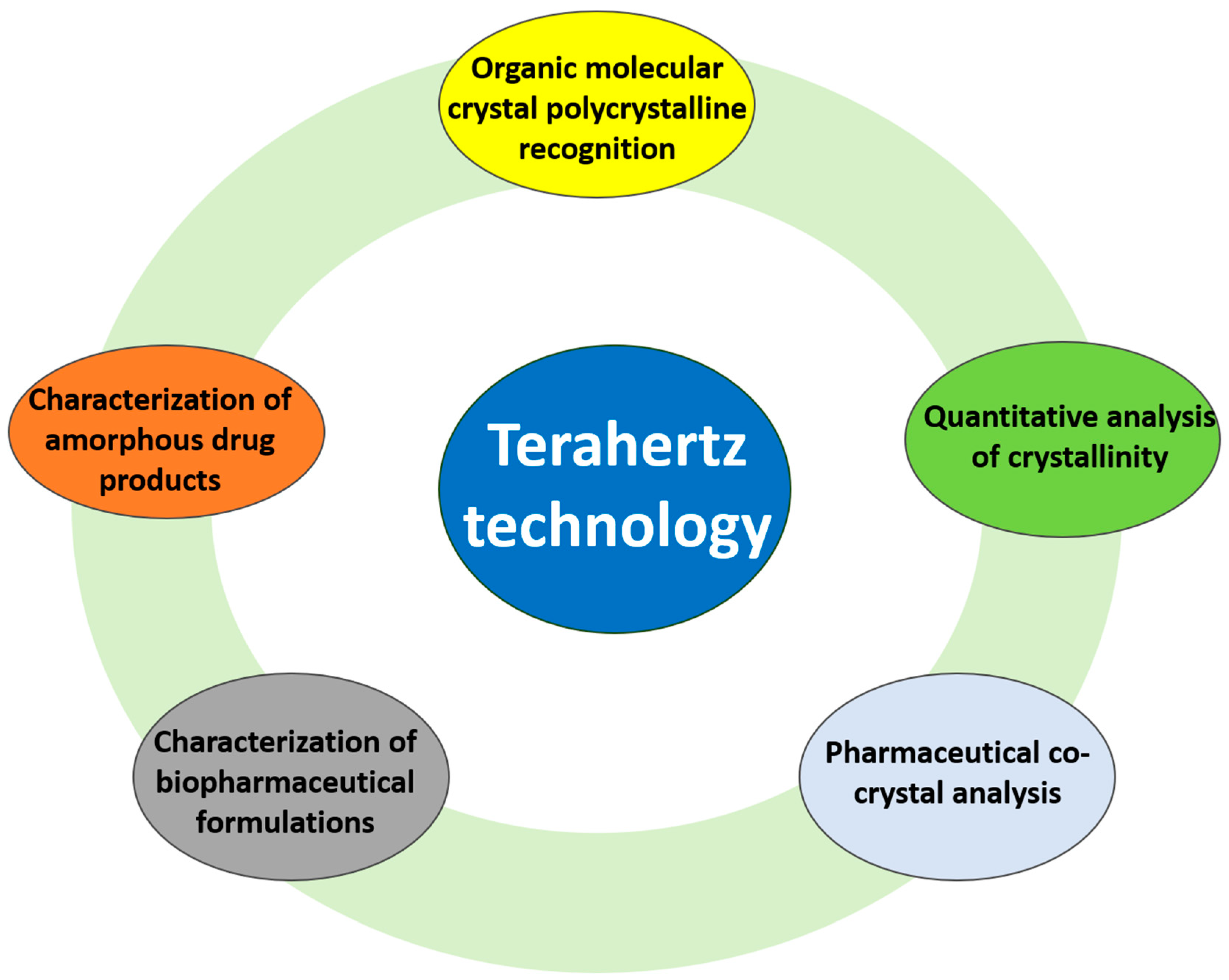

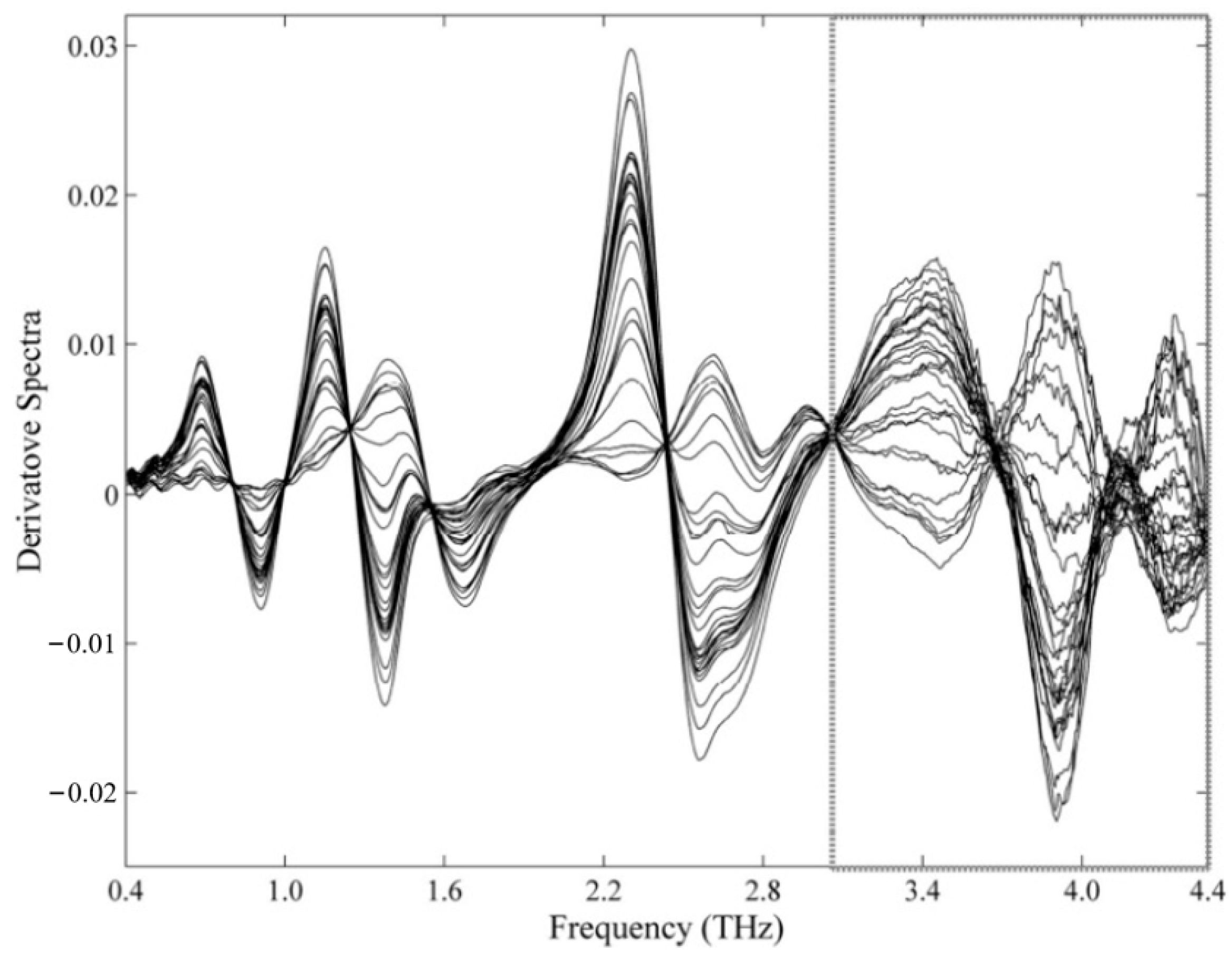

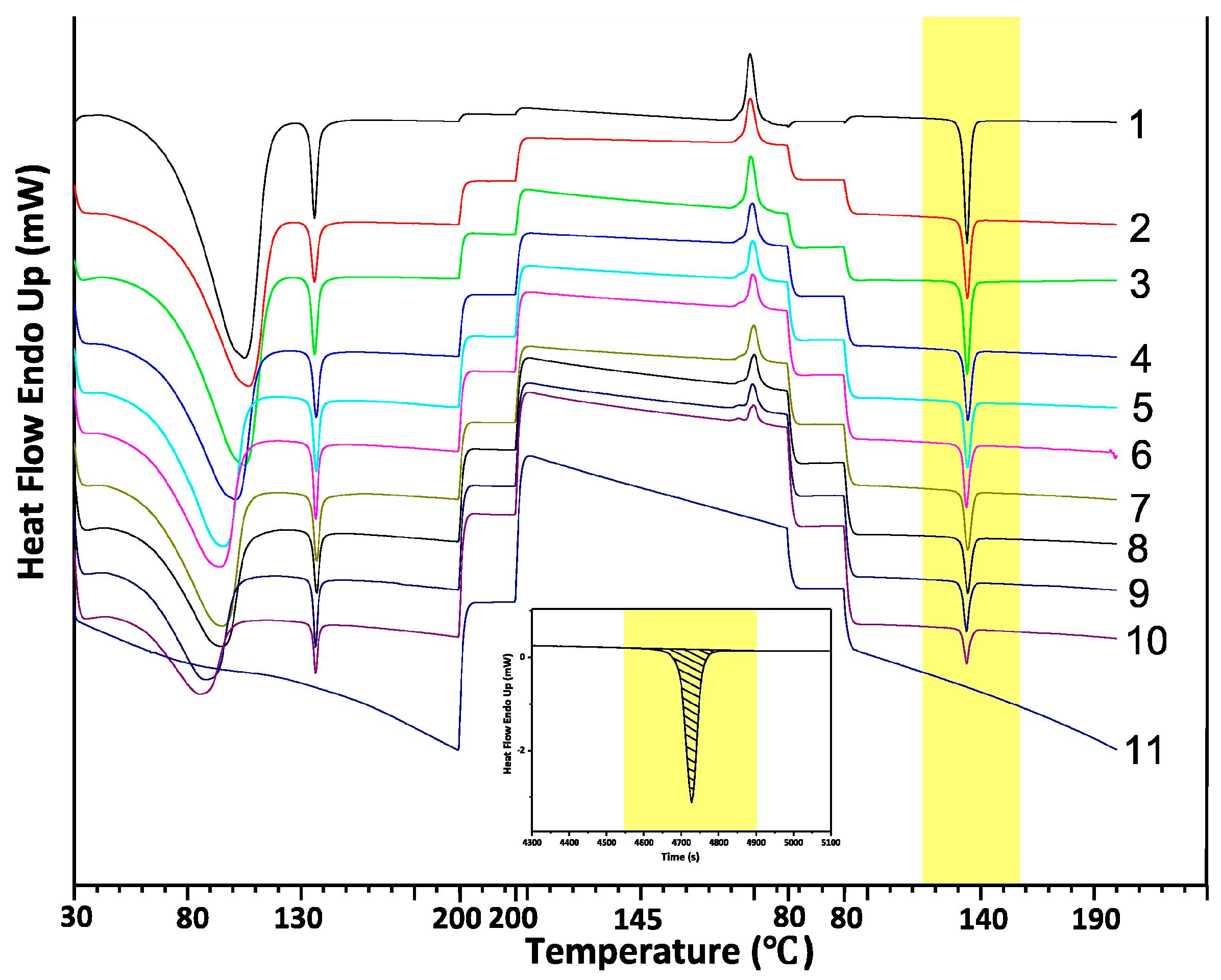
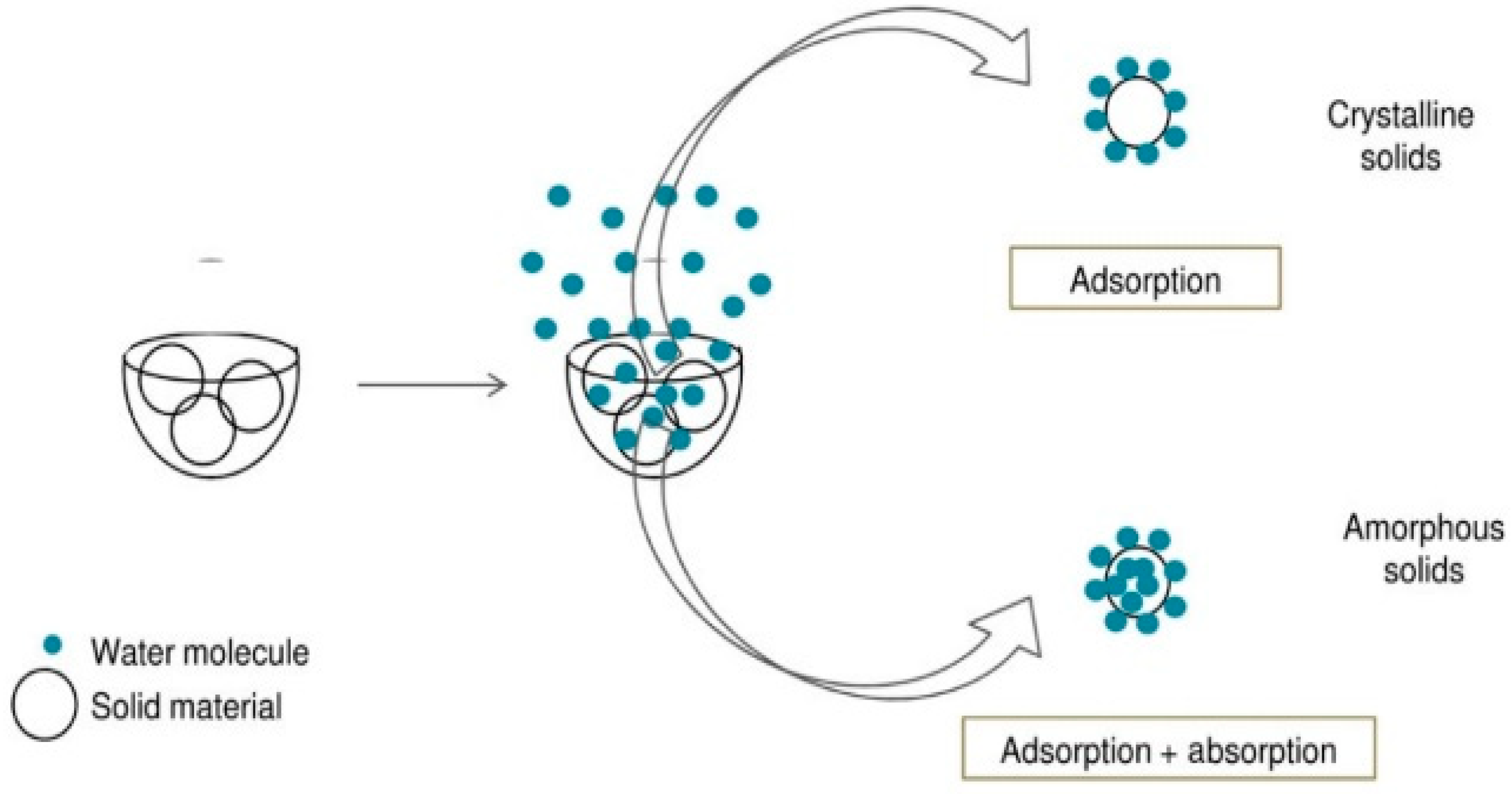

| Analysis Method | Principle | Formula | Advantages | Disadvantages |
|---|---|---|---|---|
| Internal labeling method | To eliminate the influence of the matrix effect, a pure substance’s phase is added to the specimen as a standard substance. | The internal standards are generally affected by matrix absorption, experimental conditions, etc. of the same extent; Ij/Is values do not vary with sample composition or experimental conditions. | Some internal standards are difficult to obtain. Multiple binary standard mixes need to be configured, and the amount of internal standard added should be strictly consistent. | |
| External standard method (adiabatic method) | The K-value method is simplified. The mass fraction of the phase to be measured can be calculated by determining only the reference intensity value of the phase to be measured. | It is simpler than the K-value method because there is no need to mix the internal standard. The chance of chance error introduced by the operation process is smaller, so the experimental error is smaller. | It is not easy to determine the reference intensity of the phase to be measured; this method cannot be used if an amorphous phase is present in the sample. | |
| K-value method (substrate cleaning method) | The K-value method is the improvement of the internal standard method, and the introduction of the constant K, where K-value is the slope of the calibration curve in the internal standard method. | It can avoid the influence of matrix absorption and is easy to apply. It eliminates the tediousness of making standard curves; it simplifies the analytical procedure, and the calculation is also simpler, with better reliability of results. | A pure sample of the phase to be measured must be prepared, and a series of experimental samples with known mass fractions of the internal standard must be prepared. The experimental procedure is tedious and complicated, and it is easy to introduce accidental errors; thus, the experimental results are more inaccurate. |
| API | Solid Form | Methodology | Limit of Detection (LOD)/Limit of Quantification (LOQ) | Reference |
|---|---|---|---|---|
| Warfarin Sodium | Crystallinity | Calibration curves for crystal content and peak intensity in powder mixtures were constructed. | The LOD for M1, M2, M3, and M4 was 3.04%, 3.17%, 4.17%, and 4.49%, respectively, while the LOQ was 9.21%, 9.62%, 12.65%, and 13.30%, respectively. | Siddiqui et al., 2015 [31] |
| Eletriptan hydrobromide | Binary mixtures of eletriptan hydrobromide in α and β crystalline forms | The non-interfering peak of exaltriptan β-type was chosen at 2θ = 5.4080 position for quantification. | LOD: 2.06% w/w LOQ: 6.09% w/w | Kommavarapu et al., 2015 [32] |
| Co-Amorphous Naproxen-Indomethacin | crystalline naproxen, γ-indomethacin, α-indomethacin as well as co-amorphous naproxen-indomethacin. | partial least square (PLS) regression model | Between 3.11% and 3.45% for the crystalline molar fractions and 5.57% for the co-amorphous molar fraction. | Beyer et al., 2015 [33] |
| Mixed pharmaceutical powders of caffeine anhydrate, Acetaminophen, and lactose | Fifty-four PXRD curves for 9 sample powders (n = 6 each) | Conventional peak intensity method and multiple curve resolution (MCR)—alternating least squares (ALS) and partial least squares (PLS) | The R2 for CA, AA, and LC in the range of 5.0–30.0 degrees was 0.988 (a), 0.989 (b), and 0.997 (c), respectively. | Otsuka et al., 2016 [34] |
| Linezolid (LZD) | LZD trace in crystalline Type IV and crystalline Type II | Single-peak method with Rietveld refinement | The LOD and LOQ were 0.4% and 1.2% (single-peak method) and 0.2% and 0.6% (Rietveld method) in APIs and 0.6% and 1.9% in tablet formulations, respectively. | Sun et al., 2017 [35] |
| Piracetam | Forms II and III | MSA approach combined with NAS program | LOD (w/w%): NAS: 0.75%; RootProf: 0.82% | Zappi et al., 2019 [36] |
| Paracetamol | Form I | MSA approach combined with NAS program | LOD (w/w%): NAS: 0.1%.; RootProf: 0.50% | Zappi et al., 2019 [36] |
| Tacrolimus | Crystal API | Slow-scan PXRD and validation of analytical methods | LOD: 0.1% LOQ: 0.2% | Sadul et al., 2020 [37] |
| Quantitative Technique | Solid Form | Methodology | LOD(w/w)/LOQ(w/w)/ Root Mean Square Error (REMSE) | Reference |
|---|---|---|---|---|
| NIRS | Mebendazole (MBZ) forms A, B, and C | Near-infrared spectroscopy and Jack–Knife algorithm (PLS/JK) selected variables with significant regression coefficients to develop partial least-squares (PLS) regression models. | The LOD values of MBZ polymorphs A, B, and C were 3.5%, 2.0%, and 4.1%, respectively. | Silva et al., 2015 [104] |
| Three cimetidine polymorphs (A, B, D) and the mixed crystal (M1) | PLS and LS-SVM quantitative modeling | The RMSEP was 0.0471, 0.0529, and 0.0594, respectively. | Feng et al., 2015 [105] | |
| Mefenamic acid (MFA) crystal I | Partial least-squares (PLS) regression | LOQ: 0.10% | Antonio et al., 2018 [106] | |
| Mebendazol (MBZ) polymorphs (A, B, C) | MCR-ALS and PLS regression models | PLS model: 2.06%, 2.15%, and 2.29% LOD for MBZ polymorphs A, B, and C, respectively; MCR-ALS: 6.65%, 5.10%, and 4.62%, respectively. | Silva et al., 2019 [107] | |
| Amorphous-state (A-) indomethacin | PLSR model | Range of 0.0000~100.0000% w/w% | Liu et al., 2024 [108] | |
| DRIFTS | Polymorphic form I in commercial form III of fusidic acid | Partial least-squares (PLS) regression and support vector machine (SVM) regression to build quantitative models | RMSEP range of 0.48% to 1.17% | Guo et al., 2017 [109] |
| Naringenin–carbamazepine drug–drug cocrystal | ATR-FTIR and Raman spectroscopies combined with partial least squares (PLS) and principal component regression (PCR) | RMSEP and squared correlation coefficient (R2) of the model were 0.101, 0.132, and 0.870, respectively. | Xie et al., 2024 [110] | |
| Pyrazinamide polymorphs in ternary mixtures and polymorphic forms (α, δ, γ) | Partial least squares (PLS), multiplicative scatter correction (MSC), denoise, median, and first derivative | RMSEP of 5.3%, 21.6%, and 20.8% for polymorphs α, δ, and γ, respectively. | Zhou et al., 2023 [111] | |
| Raman | Crystallinity in amorphous griseofulvin tablets | Partial least-squares (PLS) regression analysis | LOD: 0.58% LOQ: 1.77% | Mah et al., 2015 [112] |
| Piroxicam forms α, β2, and monohydrate | Partial least-squares (PLS) regression analysis | RMSEP values for the α, β2, and monohydrate forms were 2.7%, 3.1%, and 3.2%, respectively. | Lipiäinen et al., 2018 [113] | |
| 1:1 cocrystal of ibuprofen (IBU) and nicotinamide | Partial least squares (PLS), checking the full spectrum using standard normal variable (SNV) scattering corrections with first-order derivatives | RMSE: 0.834% | Karimi-Jafari et al., 2021 [114] | |
| Febuxostat (API) | Principal component analysis (PCA) and partial least squares regression (PLSR) analysis | The root mean square error (RMSE) of calibration and validation of the PLSR model has been found to be 2.9033 and 1.35, respectively. | Rimsha et al., 2023 [115] | |
| SS-NMR | 2-[[4-[(4 R)−4-methyl-6-oxo-4,5-dihydro-1 H- pyridazin- 3-yl]phenyl]hydrazinylidene]propanedinitrile polymorphs X1 and X2 | 13C CP MAS NMR; integration of dipole phase shift spectral signals, and direct exponential curve resolution algorithm (DECRA) for chemometrics | LOD values lower than 1% of polymorph X | Virtanen et al. [116] |
| Small amount of cimetidine in a physical mixture of cimetidine anhydrous hydrochloride (anhydrous polymorph A) | 1H double-quantum MAS SS-NMR | LOD: 1% | Maruyoshi et al., 2017 [117] | |
| Physical mixtures of theo-II and MCC | 1H MAS NMR | The average absolute error for API loading was 0.36 wt.%; the average relative error was 9.9% of the expected API loading. | Hirsh et al., 2019 [118] | |
| Pioglitazone/pioglitazone HCl | CRAMPS−MAR 1H SSNMR | LOQ:Pio-5%; PioHCl-3% | Wong et al., 2022 [119] | |
| Polycrystalline mixture of steroids, Org OD 14; 1 wt% Org-II of Org-I/-II | CRAMPS−MAR 1H SSNMR | Estimate the quantification limit to be ca. 10 wt% for Org-I and ca. 15 wt% for Org-II | Wong et al., 2022 [119] | |
| Pioglitazone free base (PIO-FB) and its hydrochloride (PIO-HCl) in binary systems | 60 kHz ultrafast magic angle spinning (UF-MAS) 1H ssNMR | LOD: 1.77% | Li et al., 2020 [120] | |
| Histidine hydrochloride monohydrate (L-histidine·HCl·H 2O) | 1H MAS NMR | LOD: about 4.6 wt% in tablets | Hong et al., 2020 [121] | |
| Benzocaine (polymorphs A and B) Piroxicam (polymorphs A and B) Naproxen (anhydrous form A and anhydrate form B) | Time-domain nuclear magnetic resonance (TD-NMR); quantitative saturation recovery curve (qSRC) | LOQ: 2–5% | Baraldi et al., 2021 [122] |
| Quantitative Methods | Sample Size | Scope of Application | Advantages | Limitations | LOD (w/w) | LOQ (w/w) |
|---|---|---|---|---|---|---|
| SXRD | <10 mg | Samples with single crystals | Determination of the type and crystalline purity of crystalline substances | Single crystals need to be cultured to obtain samples | - | - |
| PXRD | >5 mg | Powdered solid crystals | Non-invasive; easy to operate | Large experimental error | 0.1−6% | 0.2−7% |
| IR | <10 mg | Unlimited | Easy to operate; low sample volume; fast analysis | Low sensitivity; high error in quantitative analysis | 0.3–5% | 1–5% |
| NIRS | <40 mg | Sample size < 75 µm | Fast; non-destructive | Less information; low resolution | 0.2–4% | 0.1–5% |
| Raman | <2000 mg | Unlimited | Rapid; high sensitivity; no sample preparation and non-destructive | Unable to characterize or quantify individual components | 0.5−5% | 1.2−5% |
| THz | <40 mg | Sample size < 0.1 mm | Rapid non-destructive quantitative analysis | Must be measured in a water-free environment | 0.7−5% | 2–10% |
| SS-NMR | 500–700 mg | Solid-state samples | High sensitivity | Long testing time | 0.04−10% | 2−15% |
| DSC | <10 mg | Amorphous/low cocrystal system | Low sample volume required; easy to operate | Irreversible damage, not suitable for difficult to obtain or valuable samples; cannot analyze systems with poor thermal stability | 0.1−3% | 0.5−10% |
| TGA | <10 mg | Contains samples of volatile components | Easy handling | Longer measurement times; damage to samples | - | - |
| DVS | 5–50 mg | Thermally stable samples | High sensitivity and accuracy | Damage to sample | 0.2–5% | 2−5% |
Disclaimer/Publisher’s Note: The statements, opinions and data contained in all publications are solely those of the individual author(s) and contributor(s) and not of MDPI and/or the editor(s). MDPI and/or the editor(s) disclaim responsibility for any injury to people or property resulting from any ideas, methods, instructions or products referred to in the content. |
© 2024 by the authors. Licensee MDPI, Basel, Switzerland. This article is an open access article distributed under the terms and conditions of the Creative Commons Attribution (CC BY) license (https://creativecommons.org/licenses/by/4.0/).
Share and Cite
Tao, Y.; Gao, Y.; Zhang, B.; Hu, K.; Xie, Y.; Zhang, L.; Yang, S.; Lu, Y. Advances in Quantitative Analytical Methods for Solid Drugs. Crystals 2025, 15, 38. https://doi.org/10.3390/cryst15010038
Tao Y, Gao Y, Zhang B, Hu K, Xie Y, Zhang L, Yang S, Lu Y. Advances in Quantitative Analytical Methods for Solid Drugs. Crystals. 2025; 15(1):38. https://doi.org/10.3390/cryst15010038
Chicago/Turabian StyleTao, Yue, Yuhan Gao, Baoxi Zhang, Kun Hu, Yifei Xie, Li Zhang, Shiying Yang, and Yang Lu. 2025. "Advances in Quantitative Analytical Methods for Solid Drugs" Crystals 15, no. 1: 38. https://doi.org/10.3390/cryst15010038
APA StyleTao, Y., Gao, Y., Zhang, B., Hu, K., Xie, Y., Zhang, L., Yang, S., & Lu, Y. (2025). Advances in Quantitative Analytical Methods for Solid Drugs. Crystals, 15(1), 38. https://doi.org/10.3390/cryst15010038







